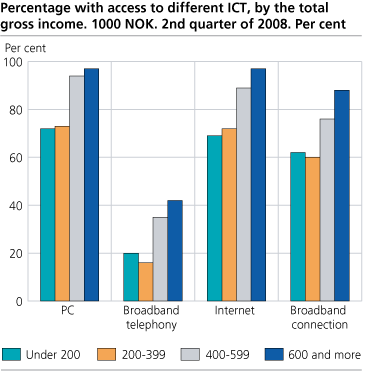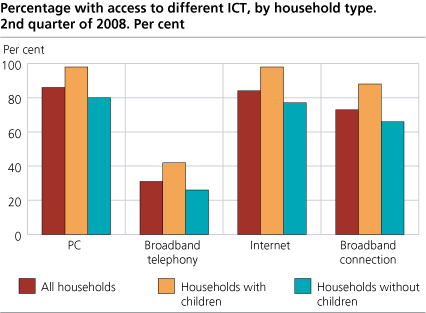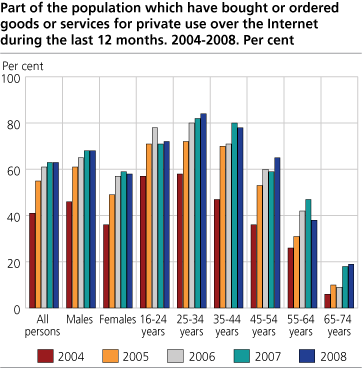Content
Published:
This is an archived release.
Rapid increase in broadband via cable-TV
Eighty-four per cent of households have access to the Internet and 73 per cent have a broadband connection. Broadband via cable-TV has become more important. Lack of interest is the main reason not to connect to the net.
ADSL, and other xDSL technologies, are the most common Internet connection in Norway. Sixty-one per cent have xDSL. This is about the same number as last year. The largest increase of 7 per cent points is found in connections by cable-TV, up from 10 to 17 per cent of all households.
Mobile connections are still quite insignificant as single access technology. Even if 5 per cent of the population aged 16-74 have a mobile broadband connection and 26 per cent have a mobile narrowband connection, only 1 per cent of households have each of these as single access technology.
Generally, families with children and families with high incomes have access to information and communication technology (ICT) more often than others. Younger people and people with higher education also have access to ICT more often than others. 88 per cent of the households with a gross income above NOK 600 000 have broadband. The corresponding figure for households with income below NOK 200 000 is 62 per cent. Compared with last year’s figures, the increase in broadband connection is 12 points for the lower income band and only 2 points for the higher band.
Half of those with no access to the Internet refer to lack of interest in the content as the main reason for not having a connection. No other single reason is mentioned by more than 15 per cent.
Continued growth in the internet use
89 per cent of the population has used the Internet during the last three months, an increase from 85 per cent in the previous year. More men and more people with higher education use the Internet every day. Some Internet activities show even higher levels of use than last year. Sending and receiving e-mail has been performed by 92 per cent of Internet users, an increase from 89 per cent last year. Corresponding figures for downloading of computer software is 47 per cent this year compared with 40 per cent last year.
The Internet as an important communication channel, especially for the younger generation, is well documented. 91 per cent of internet users in the age band 16-24 years have used MSN. The corresponding figure for chatting is 59, for reading weblogs is 51 and for creating own weblog is 18 per cent. Internet use has effects on other means of communication like the use of both mobile and fixed telephones and e-mail. Reading printed newspapers is very much affected by 23 per cent and to some extent by an additional 43 per cent of Internet users. Buying a CD or a DVD is partly replaced by downloading music or films from the Internet. More than half of the internet users have reduced their personal contact with public services and administrations very much (15 per cent) or to some extent (40 per cent).
Decreasing growth-rate in Internet trade
There has been no increase in the part of the population that has bought or ordered goods or services for private use over the Internet during the last 12 months compared with the previous year. We still see some growth in the number of users for some goods or services. The most popular service for Internet trade is travel and holiday accommodation, which is used by 71 per cent of the internet traders, an increase from 65 per cent last year.
Eighty per cent of the Norwegian Internet traders have bought from national suppliers, 32 per cent from EU countries and 22 per cent from the rest of the world.
New areas for use of mobile phone
Mobile telephones are being used for other purposes than oral conversations and SMS. In the year 2008, half the population has used their mobile phones to send photographs or videos. 22 per cent have been browsing the Internet and 12 per cent have been reading e-mails using their mobile phones. The differences between gender and age bands are small, except for age groups older than 44 years who use these additional services much less than the younger groups.
|
Many other European countries produce statistics on ICT usage in households in cooperation with Eurostat, the Statistical Office of the European Communities. The plan for this survey is adapted to Eurostat guidelines. Internationally comparable figures can be found on Eurostat's web-site |
For more information about the survey, please refer to About the statistics.
Tables:
- Table 1 Percentage with access to different ICT, by household type and household income. 2nd quarter of 2008
- Table 2 Percentage with different kinds of Internet subscriptions, by household type, household income, sex, age, education and employment situation. 2nd quarter of 2008
- Table 3 Use of computers the last 3 months, by sex, age, education and employment situation. 2nd quarter of 2008. Per cent
- Table 4 Percentage of all persons that has used mobil phone for different private purposes, by sex and age. 2nd quarter of 2008
- Table 5 Use of the Internet, frequency and location of use last 3 months. Percentage of population, by sex, age, education and employment situation. 2nd quarter 2008
- Table 6 Purpose and nature of activities on the Internet the last 3 months. Percentage of Internet users the last 3 months, by sex, age, education and employment situation. 2nd quarter of 2008
- Table 7 Percentage of Internet users using e-Government, by sex, age, education and employment situation. 2nd quarter of 2008
- Table 8 The Internet uses for communication purposes the last 3 months. Percentage of population, by sex and age. 2nd quarter 2008
- Table 9 The Internet uses for communication purposes the last 3 months. Percentage of population, by sex and age. 2nd quarter 2008
- Table 10 Consequences of Internet use on other activities. Percentage of population, by sex and age. 2nd quarter 2008
- Table 11 Types of goods and services bought or ordered over the Internet for private use, the last 12 months, by sex and age. 2nd quarter of 2008. Per cent
Contact
-
Bruk av IKT i husholdningene
E-mail: ikthus@ssb.no



